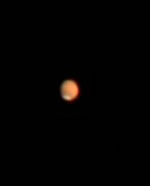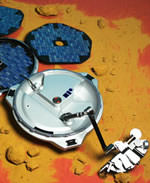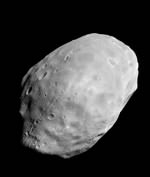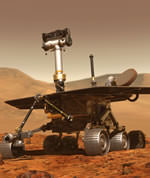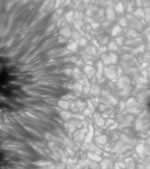
Image credit: NSO
A new adaptive optics system is helping the National Solar Observatory take much more vivid images of the Sun. Earth-based telescopes are limited in resolution by atmospheric distortion, so there was no real point of building them larger than 1.5 metres across – bigger didn’t help. With the new NSO system; however, solar telescopes can now be built 4-metres and larger. This should allow solar astronomers to better understand the processes of solar magnetism and other activities.
Impressive, sharp images of the Sun can be produced with an advanced adaptive optical system that will give new life to existing telescopes and open the way for a generation of large-aperture solar telescopes. This AO system removes blurring introduced by Earth’s turbulent atmosphere and thus provides a clear vision of the smallest structure on the Sun.
The new AO76 system — Adaptive Optics, 76 subapertures — is the largest system designed for solar observations. As demonstrated recently by a team at the National Solar Observatory at Sunspot, NM, AO76 produces sharper images under worse seeing conditions for atmospheric distortion than the AO24 system employed since 1998.
“First light” with the new AO76 system was in December 2002, followed by tests starting in April 2003 with a new high-speed camera that significantly enhanced the system.
“If the first results in late 2002 with the prototype were impressive,” said Dr. Thomas Rimmele, the AO project scientist at the NSO, “I would call the performance that we are getting now truly amazing. I’m quite thrilled with the image quality delivered by this new system. I believe its fair to say that the images we are getting are the best ever produced by the Dunn Solar Telescope.” The Dunn is one of the nation’s premier solar observing facilities.
Dual-purpose program
The new high-order AO system serves two purposes. It will allow existing solar telescopes, like the 76-cm (30-inch) Dunn, to produce higher resolution images and greatly improve their scientific output under a wider range of seeing conditions. It also demonstrates the ability to scale the system up to enable a new generation of large-aperture instruments, including the proposed 4-meter Advanced Technology Solar Telescope (see below) that will see at higher resolutions than current telescopes can achieve.
High resolution observations of the Sun have become increasingly important for solving many of the outstanding problems in solar physics. Studying the physics of flux elements, or solar fine structure in general, requires spectroscopy and polarimetry of the fine structures. The exposures are typically about 1 second long and the resolution currently achieved in spectroscopic/polarimetric data typically is 1 arc-second, which is insufficient for study of fine solar structures. Further, theoretical models predict structures below the resolution limits of 0.2 arc-sec of existing solar telescopes. Observations are needed below the 0.2 arc-sec resolution limit to study the important physical processes that occur on such small scales. Only AO can provide a consistent spatial resolution of 0.1 arc-sec or better from ground based observatories.
AO technology combines computers and flexible optical components to reduce the effects of atmospheric blurring (“seeing”) on astronomical images. Sunspot’s solar AO76 system is based on the Shack-Hartmann correlating technique. In essence, this divides an incoming image into an array of subapertures viewed by a wavefront sensor camera. One subaperture is selected as a reference image. Digital signal processors (DSPs) calculate how to adjust each subaperture to match the reference image. The DSPs then command 97 actuators to reshape a thin, 7.7 cm (3-inch) deformable mirror to cancel much of the blurring. The DSP also can drive a tilt/tip mirror, mounted in front of the AO system, that removes gross image motion caused by the atmosphere.
Closing the loop for sharper images
“A major challenge for astronomers is correcting the light entering their telescopes for the effect of the Earth’s atmosphere,” explained Kit Richards, NSO’s AO lead project engineer. “Air of different temperatures mixing above the telescope makes the atmosphere like a rubber lens that reshapes itself about a hundred times each second.” This is more severe for solar astronomers observing during the day with the Sun heating Earth’s surface, but still causes the stars to twinkle at night.
Further, solar physicists want to study extended bright regions with low contrast. That makes it more challenging for an AO system to correlate the same parts of several slightly different subapertures, and to maintain the correlation from one image frame to the next as the atmosphere changes shape.
(Nighttime astronomy has used a different technique for several years. Lasers generate artificial guide stars in the atmosphere, letting astronomers measure and correct for atmospheric distortion. This is not practical with instruments that observe the Sun.)
In 1998 NSO pioneered use of a low-order AO24 system for solar observations. It has 24 apertures and compensates 1,200 times/second (1,200 Hertz [Hz]). Since August 2000, the team focused on scaling the system up to the high-order AO76 with 76 apertures and correcting twice as fast, 2,500 Hz. The breakthroughs started in late 2002.
First, the servo loop was successfully closed on the new high-order AO system during its first engineering run at the Dunn in December. In a “closed loop” servo system the output is fed back to the input and the errors are driven to 0. An “open loop” system detects the errors and makes corrections but the corrected output is not feed back to the input. The servo system doesn’t know if it is removing all the errors or not. This type of system is faster but very hard to calibrate and keep calibrated. At this point the system used a DALSA camera, which operates at 955 Hz, as the interim wavefront sensor. The optical setup was not finalized and preliminary; “bare-bone” software operated the system.
High-speed wavefront sensor
Even in this preliminary state — intended to demonstrate that the components worked together as a system– and under mediocre seeing conditions, the high-order AO system produced impressive, diffraction-limited images. Time sequences of corrected and uncorrected images show that the new AO system provides fairly consistent high-resolution imaging even as the seeing varies substantially, as is typical for daytime seeing.
Following this milestone, the team installed a new high-speed wavefront sensor camera custom developed for the AO project by Baja Technology and NSO’s Richards. It operates at 2,500 frames/second, which more than doubles the closed-loop servo bandwidth possible with the DALSA camera. Richards also implemented improved control software. In addition, the system was upgraded to drive the tip/tilt correction mirror either directly from the AO wavefront sensor or from a separate correlation/spot tracker system that operates at 3 kHz.
The new high-order AO76 was first tested in April 2003 and immediately started producing excellent images under a wider range of seeing conditions that normally would preclude high-resolution images. The new high-order AO76 was first tested in April 2003 and immediately started producing excellent images under a wider range of seeing conditions that normally would preclude high-resolution images. Striking differences with the AO on versus off are readily visible in images of active areas, granulation, and other features.
“That’s not to say that seeing does not matter anymore,” Rimmele noted. “To the contrary, seeing effects such as anisoplanatism — wavefront differences between the correlation target and the area we want to study — still are limiting factors. But in halfway decent seeing we can lock up on granulation and record excellent images.”
To make large instruments like the Advanced Technology Solar Telescope possible, the high-order AO system will have to be scaled up more than tenfold to at least 1,000 subapertures. And NSO is looking beyond that to a more complex technique, multiconjugate AO. This approach, already being developed for nighttime astronomy, builds a three-dimensional model of the turbulent region rather than treating it as a simple distorted lens.
For now, though, the project team will focus on the completion of the optical setup at the Dunn, installation of the AO bench at the Big Bear Solar Observatory followed by engineering runs, optimization of reconstruction equations and servo loop controls, and characterization of system performance at both sites. Then, the Dunn AO system is to become operational in fall of 2003. The Diffraction Limited Spectro-Polarimeter (DLSP), the main science instrument that can take advantage of the diffraction-limited image quality delivered by the high-order AO, is scheduled for its first commissioning runs in fall of 2003. NSO is developing the DLSP in collaboration with the High Altitude Observatory in Boulder.
Original Source: NSO News Release
